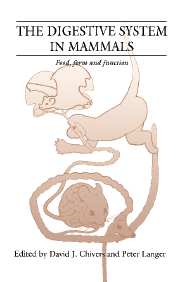Book contents
- Frontmatter
- Contents
- List of contributors
- Preface
- Part I Introduction
- Part II Food
- Part III Form
- 12 The form of selected regions of the gastro-intestinal tract
- 13 Categorisation of food items relevant to oral processing
- 14 A direct method for measurement of gross surface area of mammalian gastro-intestinal tracts
- 15 Morphometric methods for determining surface enlargement at the microscopic level in the large intestine and their application
- 16 Weaning time and bypass structures in the forestomachs of Marsupialia and Eutheria
- 17 Adaptations in the large intestine allowing small animals to eat fibrous foods
- Part IV Function
- Part V Synthesis and perspectives
- Index
12 - The form of selected regions of the gastro-intestinal tract
Published online by Cambridge University Press: 18 March 2010
- Frontmatter
- Contents
- List of contributors
- Preface
- Part I Introduction
- Part II Food
- Part III Form
- 12 The form of selected regions of the gastro-intestinal tract
- 13 Categorisation of food items relevant to oral processing
- 14 A direct method for measurement of gross surface area of mammalian gastro-intestinal tracts
- 15 Morphometric methods for determining surface enlargement at the microscopic level in the large intestine and their application
- 16 Weaning time and bypass structures in the forestomachs of Marsupialia and Eutheria
- 17 Adaptations in the large intestine allowing small animals to eat fibrous foods
- Part IV Function
- Part V Synthesis and perspectives
- Index
Summary
In this section of five chapters, the authors present information on the morphology and functional anatomy of the mammalian gastro-intestinal tract.
It is the purpose of the digestive tract to:
Reduce food particle size mechanically
Degrade macromolecules of the nutrient chemically
Absorb food constituents as well as endogenous matter through specialised structures in certain regions of the tract's wall into the blood and lymph circulatory system
Excrete indigestible components of the food as well as some of the endogenous matter
Protect the internal milieu of the body against disturbances from the external environment.
Although there is considerable morphological as well as functional diversity in the different parts of the digestive tract, a general sub-division according to functional needs can be found in practically all mammals.
In the oral cavity food is transferred from the outside world into the digestive tract. In most animal classes, dentition (if present) serves for catching and holding the food but does not necessarily reduce particle size to any considerable degree. However, in many Mammalia, especially herbivores, particulate food is reduced in size by dentition as described in Ch. 13 by Lucas. In some mammals, such as in humans, enzymatic digestion of starch starts in the oral cavity.
The pharynx and the oesophagus rapidly transport the swallowed bolus into the stomach, which in most mammals is the beginning of the region of the digestive tract where enzymatic digestion takes place. Digesta are retained in this organ for very different periods of time.
- Type
- Chapter
- Information
- The Digestive System in MammalsFood Form and Function, pp. 195 - 196Publisher: Cambridge University PressPrint publication year: 1994

